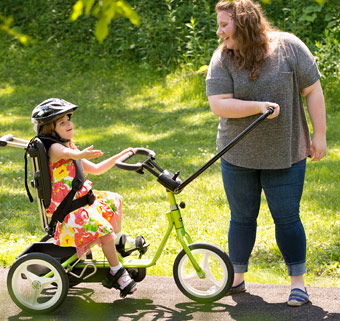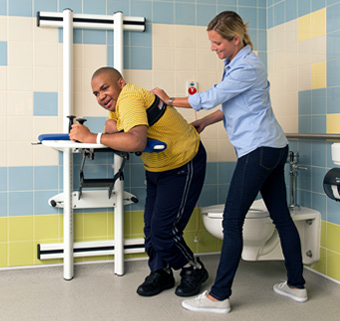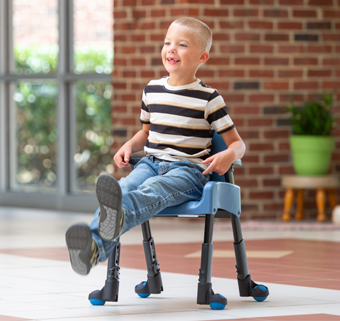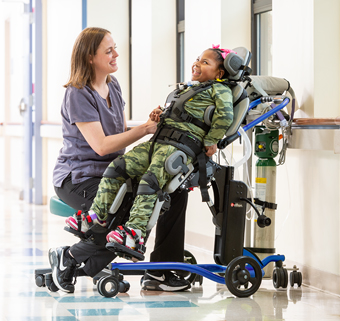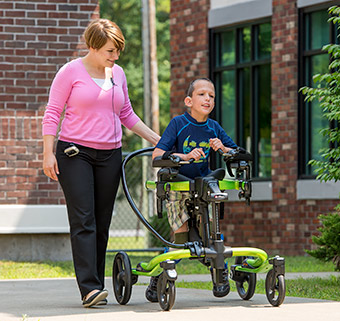Part 3: The Application of GAS to the IEP Process
| August 2020 Best practice in educational goal writing is for a goal to be discipline-free and reflective of meaningful outcomes, not only for the current IEP cycle but looking forward.
Best practice in educational goal writing is for a goal to be discipline-free and reflective of meaningful outcomes, not only for the current IEP cycle but looking forward.
Given the one variable requirement of Goal Attainment Scaling (GAS), how does this process work when developing team-oriented goals? As a team, consider big picture participation goals. The team can decide together which variable to measure based on the greatest bearing on overall student success.
GAS Used for Progression
In the sample case below, the team determined that time was the greatest concern, due to lost instructional time.
Sample Case “Time”
Area of Academic Achievement and Functional Performance: Adaptive Skills
Thom is a kindergarten student with motor impairment, who is learning to use his adaptive toilet and follow a self-care routine. The team’s current concern is that this routine takes 25 minutes to complete, and requires standby assistance. The team wants him to develop the skills in this routine in preparation for first grade, by minimizing assistance and time.
Recall the GAS process: The team’s goal for Thom will have a score of 0
- -2 is Thom’s baseline performance
Using an adaptive toilet and following a picture schedule of his toileting routine, Thom will complete the entire routine in 30 minutes with standby adult assistance. - -1 where Thom has made some improvement but not achieved the goal
Using an adaptive toilet and following a picture schedule of his toileting routine, Thom will complete the entire routine in 25 minutes with standby adult assistance. - 0 is the goal (what is expected with intervention)
Using an adaptive toilet and following a picture schedule of his toileting routine, Thom will complete the entire routine in 20 minutes with standby adult assistance. - +1 Thom has performed better than expected
Using an adaptive toilet and following a picture schedule of his toileting routine, Thom will complete the entire routine in 15 minutes with standby adult assistance. - +2 Thom has performed way better than expected
Using an adaptive toilet and following a picture schedule of his toileting routine, Thom will complete the entire routine in 10 minutes with standby adult assistance.
The other option for using GAS is to apply it to your therapist Plan of Care. (See your State Practice Act if the IEP is NOT considered a Plan of Care.)
In the above example, the team chose to track time. Let’s take another example.
Thom’s therapist wants to track another element of the goal that he/she has been specifically working on, the transfer to and from the toilet. The therapist will determine what variable has the greatest impact on Thom’s success in the transfer aspect of the goal. Using clinical judgement, the therapist determined it was Thom’s inability to stand for a long enough period of time for him to learn to pivot his feet to transfer. Currently Thom requires standby assistance of one adult to transfer to and from the toilet. He is unable to stand long enough to pivot his feet without an adult holding him at the trunk.
Sample Case “Transfer Ability”
Area of Academic Achievement and Functional Performance: Adaptive Skills
Recall the GAS process: The therapist’s goal for Thom will have a score of 0
- -2 is Thom’s baseline performance
Thom does not stand with assistance of one adult at his trunk, so that he cannot pivot his feet and transfer to and from the adapted toilet. - -1 where Thom has made progress but not achieved the goal
Thom will stand for 5 seconds with assistance of one adult at his trunk, so that he can pivot his feet and transfer to and from the adapted toilet. - 0 is the goal (what is expected with intervention)
Thom will stand for 10 seconds with assistance of one adult at his trunk, so that he can pivot his feet and transfer to and from the adapted toilet. - +1 Thom has performed better than expected
Thom will stand for 15 seconds with assistance of one adult at his trunk, so that he can pivot his feet and transfer to and from the adapted toilet. - +2 Thom has performed way better than expected.
Thom will stand for 20 seconds with assistance of one adult at trunk, so that he can pivot his feet and transfer to and from the adapted toilet.
GAS Used for Regression
Using GAS in the case of a student with a medical condition resulting in gradual deterioration of status, requires the therapist to score a -2 as regression from the current level of performance and -1 as current level of performance.
Using GAS in this matter requires the therapist to score:
- -2 as regression of performance
- -1 as current level of performance
- 0 as the expected level of performance
- +1 being greater than expected performance
- +2 being much greater than expected
Sample Case “Functional Mobility”
Areas of Academic Achievement and Functional Performance: Gross Motor, Functional Mobility
Michael is a student who is in 8th grade and has a medical diagnosis of Duchenne’s Muscular Dystrophy. He continues to want to walk as much as possible; currently he is walking to three of his classes, and to and from the bus. His team has concerns about his regularly missing instruction due to the slow speed of his gait and fatigue level at the end of the day; he is late every day for his class after lunch and his math teacher reports he is falling asleep during his period which is at the end of the day. Michael does not complain of being tired when asked.
Michael will be transitioning to high school where the demands of academics are much greater and the physical demands are more taxing, as the school environment is much larger. His therapist has selected GAS to demonstrate Michael’s regression, in order to have a discussion with the family that powered mobility might need to be considered as an option prior to his going on to high school.
The GAS regression process:
- -2: Michael’s demonstrated regression
Michael will arrive on time to one class. - -1: Michael’s current level of performance
Michael arrives on time to three classes. - 0: Michael’s expected performance
Michael will arrive on time to five classes. - +1: Michael’s greater than expected performance
Michael will arrive on time to his homeroom after walking in from the bus and will arrive on time to all his five classes. - +2: Michael’s greater than expected performance
Michael will walk to and from the bus, arrive on time to his homeroom after walking in from the bus, and will arrive on time to all his five classes.
Share with your teams the possibility GAS holds for measuring progress in our complex students.1,2 With GAS, a therapist can share progress despite a student not meeting his/her goal and can demonstrate that an intervention is effective.
In the age of Endrew, the use of GAS assists with fulfilling our responsibility to develop a reasonably calculated IEP in light of a student’s unique circumstances, and with effectively using data to drive the IEP process.3
See Part 1: Why Goal Attainment Scaling? and Part 2: What Is Goal Attainment Scaling?
References
- Ruble, L., McGrew, J., & Toland, M. (2012) Goal Attainment Scaling as an Outcome Measure in Randomized Controlled Trials of Psychosocial Interventions in Autism. J Autism Dev Disorder. 42(9): 1974–1983. Free Full Text https://www.ncbi.nlm.nih.gov/pmc/articles
- Mailloux, Z., May-Benson, T. A., Summers, C. A., Miller, L. J., Brett-Green, B., Burke, J. P., et al. (2007). The Issue Is – Goal attainment scaling as a measure of meaningful outcomes for children with sensory integration disorders. American Journal of Occupational Therapy. (61), 254–259. Free Full Text https://ajot.aota.org/article.aspx
- Gaffney., E., Gaffney, K., Bartleson, L., & Dodds., C. (2019) Goal Attainment Scaling Made Easy with An App: GoalEd. Pediatric Physical Therapy. 31(2): 225-230. Available at: https://journals.lww.com/pedpt/Abstract/2019

